What Size Wire For Bonding Gas Line
Today I'll embrace the rules for CSST bonding. Nobody cares about any of this stuff until information technology concerns a house you own or y'all're buying, and so it'due south actually important. If you came hither looking for some piece of cake and helpful tips for handy homeowners, please try again next week. I'll have a blog post nearly fall maintenance that's not bad for any homeowner. But this week, we're diving deep into a very specific topic.
First, CSST stands for Corrugated Stainless Steel Tubing. If you ain a newer home or you've recently added gas lines to your home, there's a good possibility that someone used CSST. This is a relatively new, flexible gas line used all over the country. If information technology were h2o piping, it would exist PEX. If it were electric wiring, it would exist Romex®. It's easier to install than other stuff before it, and old-school home inspectors and contractors are super-suspicious and don't trust information technology. The building code doesn't have a ton of rules for CSST; they mostly say to follow the manufacturer's instructions. Each manufacturer has a huge certificate telling you near all of the dos and don'ts, and I've institute them to all exist pretty like, as they should be.
CSST needs to be bonded. The most mutual issue that home inspectors notice with CSST is a system that hasn't been properly bonded. Bonding the CSST means that you're making certain it'southward at the same electrical potential as everything else. If CSST is installed without existence properly bonded to current standards, you take an increased risk for damage to the textile from a nearby lightning strike. If CSST is damaged, it can leak gas and crusade an explosion and/or a fire. To the best of my knowledge, all manufacturers of CSST began implementing specific bonding requirements effectually 2006. Click the image beneath to encounter a large version of the installation tag from Gastite dated August 9, 2006.
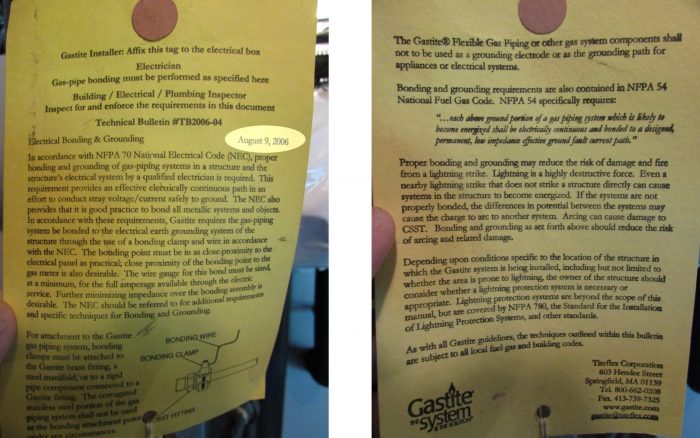
What about existing installations?Edifice codes take something called 'grandfathering'. This means that if something was installed to lawmaking, information technology's withal a code-compliant installation today, even if the codes have changed significantly. The nice thing about being a home inspector is that I don't need to get hung upward on code requirements. If something is accounted dangerous due to a modify in accepted residential construction standards, my Standard of Practice requires me to report on it, whether it met code at the time it was installed or not.
If CSST was installed to code in 2005 and the manufacturer didn't accept any special requirements for bonding at the time it was installed, the installation notwithstanding meets code today. That won't stop me from recommending this important safety upgrade, however. I'll however recommend having the organisation bonded to today'southward standards. The manufacturers of CSST have changed their installation requirements because they've learned that the old methods weren't good enough. There is an unacceptable risk of fire from a nearby lightning strike with older systems.
Where does CSST need to be bonded, inside or outside of the house?Information technology's safe to have CSST bonded either inside or outside the firm. There has been some defoliation on this topic because early editions of the fuel gas lawmaking were picky about this, but the current version of the code doesn't specify. You can bond CSST inside or outside.
Not only does the newest version of the code allow CSST to be bonded anywhere, but CSST manufacturers likewise permit CSST to be bonded anywhere. For case, Gastite says "The bonding clamp zipper point may be at any location inside the gas piping system."
What does proper bonding wait like?There needs to be a separate bonding wire continued either to the rigid gas pipage before the CSST, or directly to 1 of the CSST nuts. This is needed whatsoever time CSST is installed, fifty-fifty if it's just a pocket-size amount. The diagram below shows an example of what this would look similar when properly installed to today's standards.
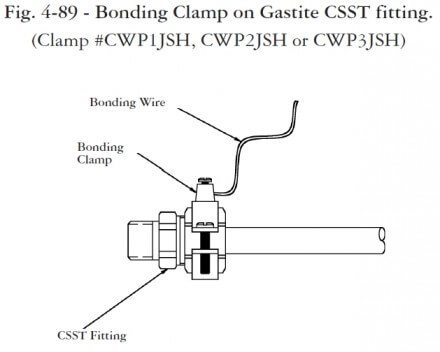
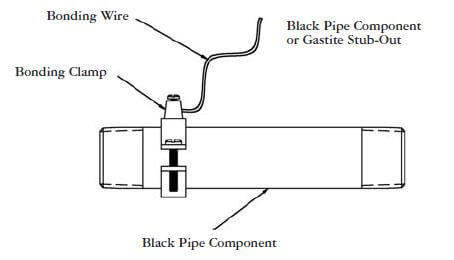
The photo beneath shows an example of CSST bonded at the outside of the habitation, with the bonding clench continued to the CSST nut.
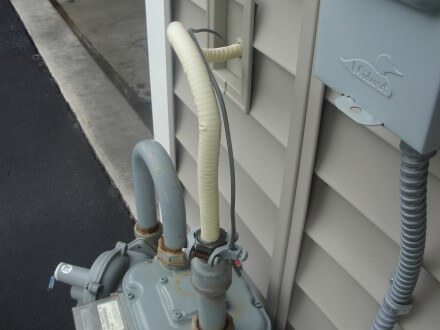
The other terminate of that wire shown above went into the main electric panel. The video beneath, produced past Gastite, shows a couple of examples of properly bonded CSST.
While the onetime method for bonding CSST required a connexion at the chief electric panel, this is no longer required by the national fuel gas lawmaking. The current Fuel Gas Code requires CSST to be bonded anywhere along the electrical service grounding electrode arrangement. That means that the bonding conductor for CSST can be connected to the metallic water piping coming into the home, a ground rod at the exterior, or anywhere else on the service grounding electrode system. This change makes it much easier to properly bond CSST. To view the current requirement, click the following link to view Department 310.2 of the 2020 Minnesota Fuel Gas Code.
What defines the grounding electrode system? Bank check out department 250.52 of the National Electric Code, which lists the following:
- Metal Underground H2o Pipage
- Metal In-basis Support Structure(southward)
- Concrete-Encased Electrode
- Ground Band
- Rod and Piping Electrodes
- Other Listed Electrodes
- Plate Electrodes
- Other Local Metal Underground Systems or Structures
One place thatisn't a proper bonding location is the intersystem bonding terminal, which can be plant at the outside of homes that have been built in accordance with the 2008 NEC or afterward. That version of the NEC was the outset to crave an intersystem bonding terminal for low-voltage communication equipment such every bit television receiver cables, satellites, and phones.
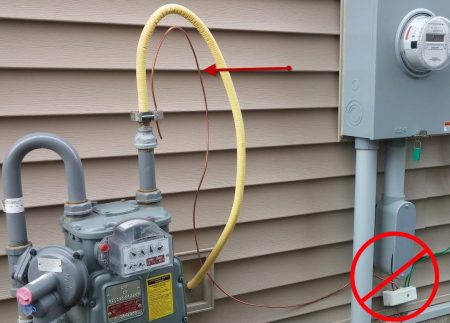
What almost the blackness stuff? Some manufacturers of CSST offer a product with a black outer "arc-resistant" jacket, which tells y'all it's an arc-resistant production. Ii examples of these products are CounterStrike® and FlashShield™. In accordance with section 310.three of the Fuel Gas Code, you probably don't need any special bonding if you have black CSST.
Side notation: I heard a rumor that the city of Maple Grove does not allow the installation of CSST. I chosen their building inspections section to ask almost this, and was told that they simply permit the installation of arc-resistant CSST products, such equally FlashShield™. The reason for this is that they're not comfortable with the installation instructions for the other stuff, which says "Care should exist taken when installing vertical runs to maintain as much separation as reasonably possible from other electrically conductive systems in the building. There is no requirement to maintain separation from other electrically conductive systems when routing FlashShield™"
When building officials accept asked the manufacturer how much distance is required, the manufacturer has left it up to the building official. Edifice officials aren't in the business organisation of testing manufacturers products for safety; that'due south supposed to be the manufacturer's job. Because the manufacturer would not requite an reply to this question, the metropolis of Maple Grove simply won't allow this product.
How can you lot know if you accept CSST in your home? Look for flexible tubing with a yellow or blackness jacket that covers the ridges. CSST either has a yellowish jacket or a black jacket. This textile is not to be confused with an appliance connector, which might have a yellow blanket that follows the contours of the ridges. The photo beneath shows the two different materials.
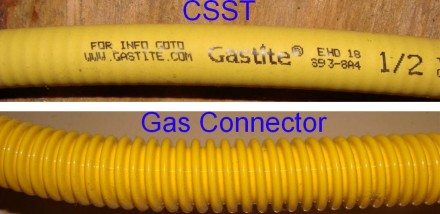
Side note: I've seen this image in numerous seminars, videos, and on various websites. I'm non boosting this prototype from anyone, because it's mine :-).
The bottom line is that if you lot have a habitation with CSST, you lot should make certain it's properly bonded to today'southward standards, regardless of whether the installation 'met code' when it was originally installed. Codes change for safety and performance. Likewise, if your electrician tells you that bonding the CSST may increase the take a chance of a lightning strike, or doesn't need to be done because the old installation "meets lawmaking", simply thank them for their fourth dimension and call a different electrician.
Additional Information on CSST and bonding
- CSST Bonding from ICC – An first-class commodity from the International Code Council
- Basics of CSST – a cursory description, a cursory history, and some basic installation requirements
Also, here's an sometime news prune of me talking to Kare xi news near CSST bonding:
What Size Wire For Bonding Gas Line,
Source: https://structuretech.com/bonding-csst-2/
Posted by: rosshunned.blogspot.com


0 Response to "What Size Wire For Bonding Gas Line"
Post a Comment